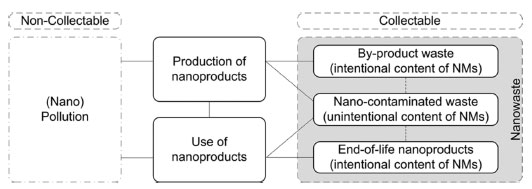| Posted: Jan 27, 2015 | |
Nanowaste - Nanomaterial-containing products at the end of their life cycle (page 1 of 4) |
|
| (Nanowerk Spotlight) Based on their special chemical and physical properties, synthetically produced nanomaterials (engineered nanomaterials, ENMs) are currently being used in a wide range of products and applications. The Nanomaterial Databank1 of Nanowerk currently lists nanomaterials composed of 28 different elements as well as of carbon (fullerenes, CNT, graphene), quantum dots consisting of several semi-conductor materials, a large number of simple nanoparticulate compounds (oxides, carbonates, nitrides) and those made up of complex compounds containing several components. On the one hand, the application of nanomaterials promises reduction potentials and sustainability effects for the environment, for example through resource and material savings (see2). | |
| On the other hand, we know very little about the behavior of nanomaterials or about environmental and health risks when these products enter various waste streams at the end of their life cycles. A better understanding of the risks in the so-called End-of-Life-Phase (EOL) calls for considering the different disposal pathways and potential transformation processes that nanomaterials undergo in waste treatment plants. In the disposal phase no consideration is being given to either the special properties of nanomaterials or to potential recovery and re-use.3 | |
| There is no special legal framework in place for a separate treatment of nanomaterialcontaining wastes (see4) or the monitoring of the processes. A prerequisite for such a framework would be exact knowledge about the nanomaterials being used, their form (species) and composition, potential transformation processes as well as about amounts and concentrations. Such information, however, is not available, and virtually no studies have been conducted on the EOL phase of products containing nanomaterials. Very little is known about how nanomaterial-containing wastes behave in thermal, biological or mechanical-biological waste treatment plants or in landfills.5 | |
| What is “nanowaste”? | |
| Nanomaterials can potentially be released into the environment along the entire product life cycle through mechanical and/or chemical effects. According to a proposal by Boldrin et al.6, nanomaterials that enter the environment from diffuse sources can be classified as potential “nanopollutants” (for example titanium dioxide nanoparticles released from sunscreen lotions in surface waters). Accordingly, the term “nanowaste” is first applicable when nanomaterials come into contact with solid wastes and can be collected separately. | |
 |
|
| Figure 1: Differentiation between “nanopollutant” and “nanowaste”, i.e. solid waste that contains nanomaterials.7 | |
| Titanium dioxide nanoparticles therefore become waste only when they are for example eliminated in wastewater treatment plants after the biological purification phase. Nanomaterial-containing sludge which requires further treatment according to the Austrian Waste Management Act (Abfallwirtschaftsgesetz; AWG) is termed “nanowaste”. Nanomaterial-containing wastes from production processes and households (e.g. production rejects or „nanoproducts”) are also classified as “nanowaste” (Fig. 1). | |
| Practical considerations dictate distinguishing between “nanowaste” and “nanopollutant” because quantifying ENMs in waste streams is a precondition for determining potential limit values. A distinction is also necessary in order to be able to differentiate the definition of “waste” in the waste legislation framework from other environmental laws. | |
| Accordingly, wastes are first subject to the Waste Management Act when there is, resp. was, an intention to discard or when their collection, storage, transportation and treatment is necessary in the public interest. | |
| European and Austrian waste legislation currently contain no nano-specific regulations8. Additional studies – in particular regarding the persistence of and changes undergone by nanomaterials in waste – will be required to be able to draw conclusions about whether nano-specific limit values might become necessary in the future. | |
| Continue to next page (2 of 4) | |
|
Become a Spotlight guest author! Join our large and growing group of guest contributors. Have you just published a scientific paper or have other exciting developments to share with the nanotechnology community? Here is how to publish on nanowerk.com. |
|
